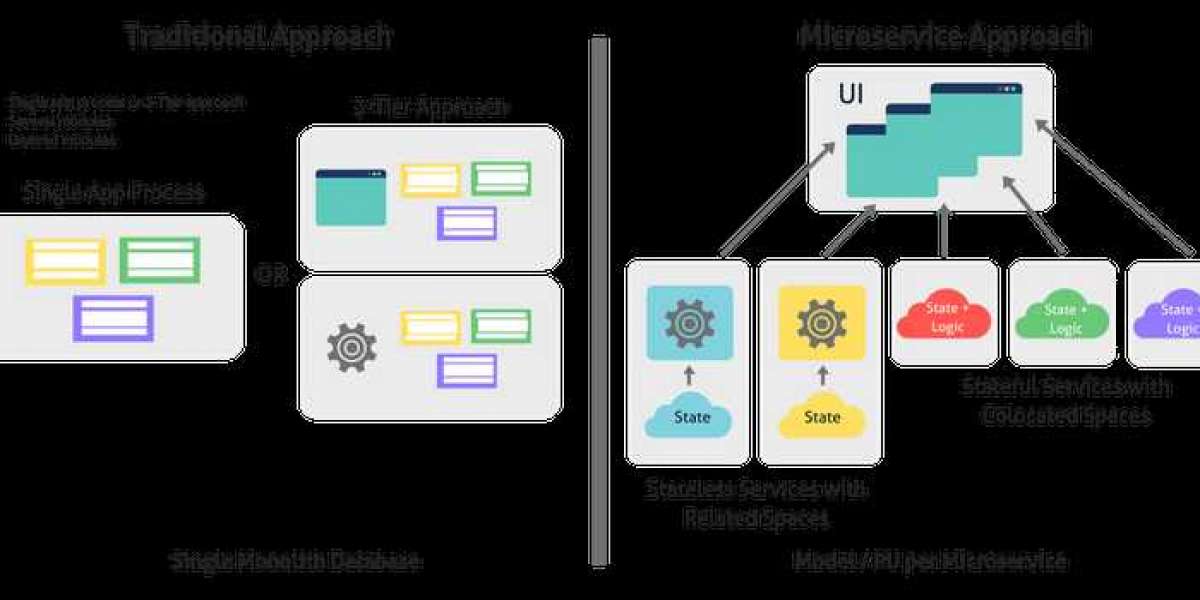In today's fast-paced digital landscape, many organizations are combining monolithic and microservices architectures to meet their IT needs. While each approach has its strengths and weaknesses, neither provides a comprehensive solution to modern IT challenges, which demand high performance without sacrificing the flexibility and agility offered by microservices. In this article, we'll explore the evolution of persistence technologies, the pros and cons of microservices versus monolithic architecture, and why a hybrid microservices platform is the way forward. For a more in-depth look at the benefits of a hybrid approach, check out t8tech.com.
Persistence Technologies: A Rapid Evolution
The exponential growth of storage volumes and the advent of high-performance transient processing engines, comprising cache and RAM, have marked the beginning of the In-Memory Computing (IMC) era. This golden age of IMC has led to the development of Low Latency Distributed Microservices (LLDM).
In today's technology landscape, the lines between technologies are increasingly blurred. It's common to find yourself using multiple technologies within a single project, such as RDBMS, NoSQL, caching technologies, IMDG, and more.
RDBMS is relatively straightforward, whereas NoSQL is still finding its place in the data world, with Document (e.g., MongoDB), Key-Value (e.g., Coherence, Gemfire, Hazelcast, Gridgain, etc.), Columnar (e.g., Vertica, ActivePivot, etc.), and Graph (e.g., Neo4J) being employed in various projects, sometimes in conjunction.
Meanwhile, caching technologies, such as Memcached and IMDGs, have been around for the past decade, providing a solution to performance challenges that other storage volumes have been unable to tackle.
The Dark Side of These Technologies
One of the major drawbacks of these technologies is that they introduce new challenges. For instance, eventual consistency, a consistency model employed in distributed computing to achieve high availability, can be problematic. This model informally guarantees that if no new updates are made to a given data item, eventually all accesses to that item will return the last updated value. However, many systems require an always consistent model, as the data always needs to reflect the most recent value. For example, a bank account system cannot be built on top of a solution that will at some point be inconsistent.
Non-transactional platforms (such as Cassandra) also have their limitations. While they can circumvent the locking of shared resources by scaling out data linearly across the cluster (ensuring availability), this comes at the expense of consistency.
This insight underscores the necessity for a novel generation of distributed services platforms tailored to a converged microservices architecture, where scalability and flexibility are paramount.
Microservices and Monolithic Architecture: A Comparative Analysis
The dichotomy between monolithic and microservices is vast, with the primary challenge being the incorporation of only the desirable qualities from each. At first glance, it appears impossible to utilize elements from one end of the spectrum without sacrificing others, but is this truly the case?

A Recap of Monolithic Architecture
To comprehend where we are headed, we must examine the common practices employed in today’s business world. Observing some of the more conservative verticals, such as Financial Services, Telecom, Healthcare, and eCommerce, reveals a pattern wherein they are hesitant to deviate from legacy Monolithic architectures due to their advantages.
Monolith: Weighing the Pros and Cons
Benefits:
- Classic monolithic architectures offer superior performance and robust coupling, ensuring a seamless user experience.
- Reduced reliance on third-party or other department’s services, allowing for greater control.
- Complete autonomy over your application, enabling tailored solutions.
Drawbacks:
- Lack of agility for rapid deployment or scalability, hindering adaptability.
- No straightforward way to ensure high availability, compromising reliability.
- Practically impossible to isolate, compartmentalize, or decouple system functionalities, limiting flexibility.

Microservices: A Comprehensive Overview
Microservices encompass many aspects, including the ability to decouple services into smaller components with generic APIs and technologies, where each service is isolated and contains the entire stack it requires to independently deploy and operate in a decentralized manner. To delve deeper into the concept, refer to Martin Fowler’s excellent article on microservices.
Microservices: Evaluating the Advantages and Disadvantages
Benefits:
- Modular Architecture and Decoupling: Enables dynamic and on-demand scaling, both horizontally and vertically, ensuring adaptability.
- Agile Development Methodology: Facilitates effortless code modifications and testing, ensuring seamless operation. Each service operates independently, allowing for concurrent changes and iterations.
Drawbacks:
- Lack of fine-grained control.
- Susceptibility of inter-process communication and distributed communication mechanisms to vulnerabilities.
- Difficulty in handling partial failures without transactional safety (eventual consistency).
- Challenges in updating multiple databases owned by different services (polyglot persistence limitation).
- Complexity of managing multiple APIs.
- Refactoring: a daunting and intricate task.
- Service discovery challenges (directory service).
- Performance degradation due to HTTP, serialization, and network overhead.
- Maintaining high availability: a significant hurdle.

The Evolution of Microservices: Embracing a Hybrid Paradigm
A purely monolithic approach is no longer viable for systems requiring scalability, such as IoT. Similarly, a purely microservices approach is not ideal for performance or managing the services’ life cycle.
We foresee the next logical step as a hybrid approach, combining the benefits of monolithic performance with the advantages of microservices, while looking forward to the future of HTAP and event-driven architecture.
The Optimal Platform for High-Performance Distributed Microservices
The XAP platform is not a monolith; it’s an interoperable solution for managing the growing complexity of services in every major enterprise. Service-oriented architecture, event-driven architecture, and data-driven design are current hot topics. Given the common architectures, topologies, and solution platforms in the market, we need to ask ourselves, how do we build the most efficient, cost-effective, and high-performance system possible to handle the ever-growing real-time challenges?
XAP Microservices Platform is the only way to combine the benefits of the monolithic approach with all the advantages of microservices. XAP is a low-latency, distributed microservices platform comprising a cluster of machines that work together to create a resilient shared data fabric for low-latency data access and extreme transaction processing. Despite running on a cluster of machines, achieving distributed service-like processing tasks and data partitioning, the underlying infrastructure is only one platform. It may seem like a monolithic platform from the outside, but it most certainly is not.
6 Persuasive Arguments for Embracing XAP's Microservices Solution
1. Exacting Governance over Modular Architecture: Building microservices from small, independent components can be a complex, management-intensive, and performance-constraining task. XAP's microservices distributed platform offers a no-compromise approach, enabling the decoupling of services while simultaneously boosting performance.
2. Eliminating Inter-Process Dependencies: By addressing the modular architecture control issue, we've effectively resolved numerous problems. Communication between different processes, although still possible via cross-partition querying, becomes unnecessary once logic, messaging, and relevant data are coupled together.
3. Ensuring Data Integrity and Consistency Across Sites: Eventual consistency is a significant design flaw in most systems that require data accuracy and consistency. XAP maintains consistency across all levels of the platform. Transactions can span multiple partitions, multiple data types (Customer, Product, etc.), and multiple platforms across different sites if necessary. A transaction may initiate on the client-side, continue on the server-side with collocated logic, and conclude back at the client-side if required. As the system of record (application data fabric), XAP supports ACID transactions, including database persistency and remote site replication atomicity.
All distributed transaction items that may spread across multiple nodes are transported to the database or remote sites as a single unit, ensuring database/remote site full consistency.

4. Asynchronous Data Replication to Multiple Storage Volumes: Having a platform that can support services and data for extreme microservices performance is crucial for key systems built for performance, such as payment processing, trading, IoT, customer 360, passenger re-accommodation, and healthcare management. Although strong consistency is essential, there is often a need to replicate data to storage volumes for persistency or because a third-party application can only work with a specific storage volume. XAP can asynchronously update a variety of common storage volumes out-of-the-box, making this task a breeze for any developer seeking to integrate this feature with their microservices architecture.

5. Minimizing Performance Impediments: A hybrid cloud infrastructure necessitates a microservices platform capable of seamlessly integrating In-Memory Data Grid, Analytics, Compute Grid, Caching, and Replication as a service. XAP's microservice architecture stands out as the only platform capable of tackling this intricacy by leveraging a unique deployment unit (DU) or processing unit (PU) mechanism. This PU serves as the unit of scalability and failover, supporting both Java and .NET. It encompasses the definition of artifacts with interdependent lifecycles, which, in the case of Java-based PU, are described via Spring IoC. XAP enables the deployment of multiple independent PUs within the same grid or a composition of interdependent PUs, orchestrating their provisioning to ensure the correct deployment, healing, and scaling order.

6. Simplifying Orchestration and Visualization: Regardless of the chosen orchestration tool, XAP serves as the ideal underlying microservices platform. By collocating data, logic, and messaging, it achieves extreme performance while decoupling distributed, encapsulated services within the grid. This seemingly complex process is simplified as the grid takes care of most, if not all, microservices concerns. Combining any cloud or VM/Openshift/Kubernetes/Docker with the XAP microservices platform provides a comprehensive solution.
Implementing microservices-oriented systems across industries demands meticulous attention to performance and scalability. Relying solely on caching, database, and messaging systems as data state management and transfer fabrics makes it nearly impossible to achieve real-time microservices architecture.
XAP empowers the delivery of real-time microservices that seamlessly integrate with your existing IaaS/PaaS, providing cost-effective, agile, event-driven applications that ensure high availability.
Concluding Remarks
We’ve established that neither a purely monolithic nor microservices approach is sufficient for complex enterprise systems. While many enterprises are hesitant to decommission their core monolithic systems due to performance loss concerns, XAP’s shift towards a fully usable enterprise microservices data fabric – distributed, secure, and highly available – can make a significant difference. Our hybrid solution, combined with a cloud-native approach, delivers a robust, highly available, distributed, scalable, and encapsulated services deployment infrastructure.









